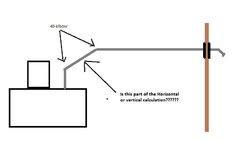I am having a heck of a time figuring out which way I want to set up my system. The best location for ease of running the duct would require more than allowed for a horizontal run. The question I have is how is a 45 degree run calculated as?
The Harman PF100 states it can go 18' for a horizontal run and 30' for a vertical. Then, each 45 or 90 subtracts from the length allowed. But, how is a 45 degree run calculated as?
I have attached a picture
The Harman PF100 states it can go 18' for a horizontal run and 30' for a vertical. Then, each 45 or 90 subtracts from the length allowed. But, how is a 45 degree run calculated as?
I have attached a picture


